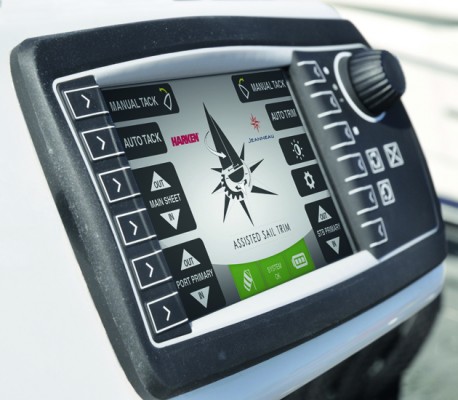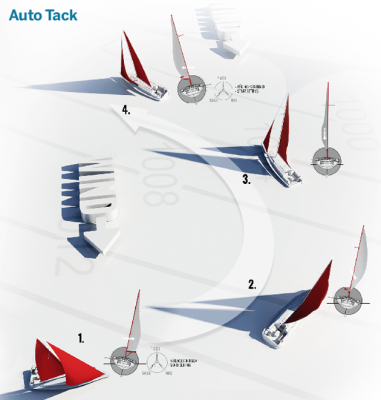This new Assisted Sail Trim (AST) program, developed by Harken and Jeanneau, uses sensor-driven reversible or captive winches to allow a yacht’s sails to be trimmed, tacked or even furled automatically, writes Toby Hodges
Is the new Assisted Sail Trim (AST) program from Jeanneau and Harken sailing’s equivalent to Google’s driverless car? In essence, the system means all sail handling can be controlled from a single screen at the helm station.
The AST computer compiles data from onboard electronics, including wind, compass and gyro information from the autopilot to command the winches. It can trim the boat automatically, according to wind direction or course heading.
Who’s it for?
The advantages of AST are easy, safe sailing, when cruising short-handed on large yachts.
“The big question we had to address was who are we looking to help?” says Jeanneau’s sailboat product director Erik Stromberg. He explains that there are complicated winch systems already aboard most 50ft plus yachts, but these can’t speak to each other. So the technology was already in place to cater for the current trend of people sailing bigger boats with fewer crew aboard.
“The electronics have moved to the cockpit, the winches from the coachroof aft – large yachts are becoming easier for one person to handle. AST is a logical step: it’s following that market trend.”
AST was developed with Harken over a three-year period aboard a Sun Odyssey 519 and is designed for use initially on the 50ft plus range. “A couple will sail a 64, while you may have eight people aboard a 34-footer,” Stromberg reasons. This system will cost the same whatever the size of boat, however – €15,000 on top of the electric winches that would typically be standard on a 50-footer. So it makes more economic sense on larger yachts.
Jeanneau believes that the take up of AST will be similar to its Dock n Go joystick motoring system, an option chosen by 20 per cent of owners of 45ft plus yachts.
AST started with Harken’s idea for a fully automated boat. The fact that Harken and Jeanneau used a proper prototype testbed for their live testing – before anyone outside the development team knew of its existence – is impressive, and shows how seriously the project is being taken.
The automated yacht
Stromberg explains that the biggest challenge was getting the hardware and electronics to talk to each other. Incorporating sensors on the winches to make sure they run at the correct speed was key.
Full production units are now at the assembly stage and Jeanneau has the exclusive use of AST with Harken for the first year. “There are many extra features that will be easy to add in,” says Stromberg. “But we chose to communicate it our end with a limited number of functions that are most useful to the customer.”
AST is operated via a dedicated industrial screen. There is nothing to stop the system moving to multifunction displays, but it’s a choice Jeanneau avoided as it feels these are already too cluttered. A Sail Management package is available that can raise and furl the sails. Load sensors will detect jams and ease halyards.
There is a manual mode, which allows the operator to tune and trim, or open up the automated functions. But Jeanneau stresses that you still have to trim the sails properly first, as the computer learns from this. “We didn’t want to link it to the autopilot for Auto Tack – you have to push a button to do it, so you have to be at the helm, in control.”
And even those who elect to have an AST system on board needn’t necessarily activate the system. “You can still own a Ferrari with cruise control, without being a poor driver,” says Stromberg.
So it is now possible for a computer not only to steer and dock your yacht, but to set, trim and tack the sails too. No doubt it will prove as controversial as it is intriguing. €15,000 (£11,016) www.jeanneau.com
Auto tack
The helmsman engages the function and turns the wheel through the tack, while AST releases one winch and trims the new working one to the same trim angle as on the previous tack. It is not linked to the autopilot, so the helmsman remains in control
Auto Trim
Auto Trim is comparable to the cruise control function in a car. It is particularly useful for long-distance sailing – as either the boat’s heading or the wind direction changes, the sheets can adjust themselves automatically








